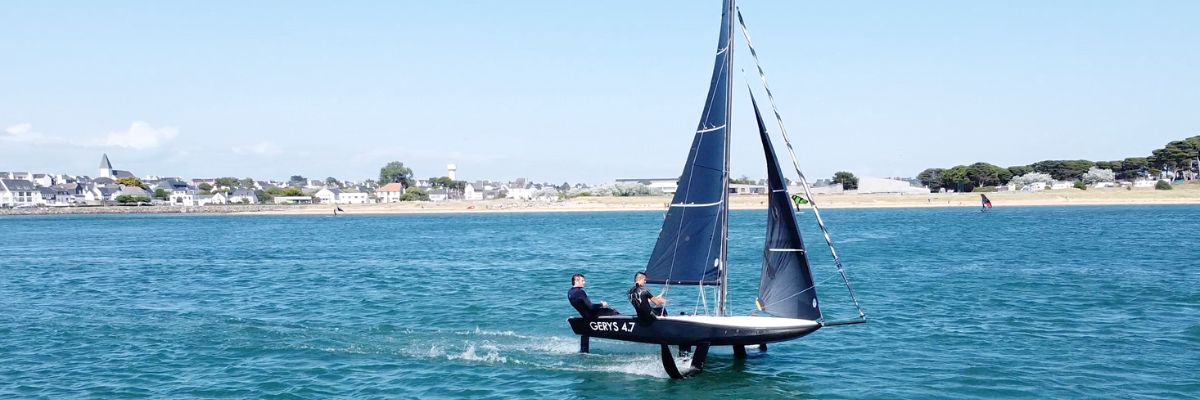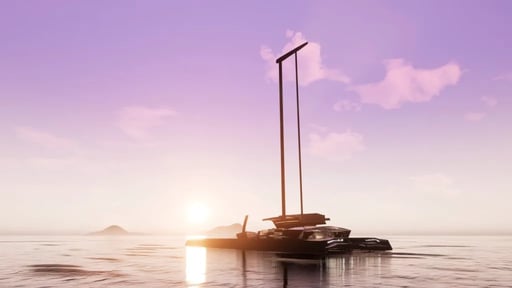 Hans Buitelaar
Hans Buitelaar
Speeding above the water like a flying carpet requires magic. After professional sportsmen set the example, aspiring sailors and speeding boaters embrace hydrofoils. These underwater wings need control. How is this magic done?
High-speed sailing with the boat hull flying above the water outlines the pinnacle of sail racing, boasting a crew of the very best sailors in the world on board to control the sail and – more critically – the foil trim. America’s Cup teams reach speeds up to 50 knots and are only able to do that with the utmost concentration of professional sportsmen. More than a decade has passed since the 2013 America’s Cup that was raced with 72 foot catamarans on hydrofoils.
The AC has intensified the focus on foiling enormously. Hydrofoil technology has been applied on to lot of sailing and motor yachts. In sailing, reaching ever higher speeds has been the driving motivation for the introduction of foiling boats.
For motor boats, lifting the hull above the surface is mostly motivated because of the immensely reduced drag. This allows navigating at high speeds using very little energy – be it fuel or battery capacity.
Hydrofoils that lift the hull above the water even provide a ride that is much less influenced by the waves, increasing comfort aboard. With all the speed, reduced drag, energy saving and comfort advantages: is foiling available for leisure boaters? Can cruisers and daytime recreational yachties profit from lifting their boats on hydrofoils without the foil control skills of rock star sailors? Ever more yacht builders offer foiling for leisure boating.
Automated control or self-adjustment of the hydrofoils’ lifting force is key when leisure boaters want to go foiling. The first foiling yachts for the broader audience are available today offer different types of foil control. How do these yards do it and do their solutions offer the speed and comfort to help inexperienced sailors fly safe?
Lightweight watercraft can get up on foils at relatively low speed, as demonstrated by Stand Up Paddlers that get their boards out of the water and up to their foils by paddle force only. It is with small light personal watercraft that foiling is first reaching a leisure audience. Paddlers control their ride height and the lifting force of the hydrofoil by muscle power.
Wing foilers have a small inflated sail in their hands while standing on a small board with a hydrofoil. When they turn their handheld sail in the wind to get forward thrust, the board will gain speed and lift the person and their sail out of the water.
The rider controls ride height by adjusting the force of the wind in the sail. This goes also for Windfoilers, windsurfboards fitted with hydrofoils. Likewise Kite Foiling.
Riders on e-foils (boards with electric motors attached to the foil) can adjust the ride height by leaning forward or backward or by stepping forward or backward. They could also control the speed with the remote they hold in one hand, although pushing a button with your thumb while balancing is a matter of subtle gestures and experience. The personal watercraft side of foiling requires some athletic capacity from the riders, because they need to power and balance their boards with their bodies.
Moving up in boat size, open sailing boats are in the market like the Moth and Waszp. These are racing one design classes and have one central T-foil and a second T-foil on the rudder. A foil shaped like an aeroplane wing lies horizontally underwater, connected to one vertical strut central from the hull.
Moth or Waszp sailing still requires a lot of acrobatic balance from the sailors. Ride height is controlled by a canting flap on the horizontal wing underwater. The angle of the flap provides more or less lift.
This flap cants mechanically controlled by a small float that is connected to a rod on the bow. If the boat rises high, the angle from the bow to the float will increase and the flap at the hydrofoil will change to a more moderate angle to reduce lift. And the other way round.
Logically, it is much easier to maintain balance on foils with multihulls, as foils can be mounted alongside each other on the different hulls. The UFO foiler beach catamaran benefits from this principle, having T-foils on each hull, providing a stable ride. Same goes for the Belfoil and iFly catamarans, like many other multihulls on foils that are available. These cats (mostly) use the floater mechanical ride height control.
The monohulls Quant 23, Gérys 4.7 and Flo 1 are much easier to sail, as they have 3 surface piercing foils. This type of hydrofoil regulates the ride height by design.
Foils are v-shaped or curved. When the boat lies still or sails at slow speed, the foils are submerged. When gaining speed, lift is generated and the boat will rise. As speed increases, the lifting force increases. But when a smaller section of the v-shaped foil is under water, the surface generating lift is smaller and thus the lifting force will be less.
This way, v-shaped or surface piercing foils will regulate the lift by design. No automated control is needed. The fact that foils come along the water surface, causes a little more drag than T-foils. These surface piercing foils were the lifting devices of long time standing record holder Hydroptère, the large French foiling trimaran. Even on big yachts, the principle of controlling lift by having less foil surface in the water with increasing speed, works flawlessly.
Flying above water goes best with light weight boats. As yachts get larger and heavier, more control is required.
Regatta sailors are prepared to take risks for speed, like on the foiling Transat 6.5’s or the Bénéteau Figaro 3. The foils on the Figaro are not explicitly meant to lift the hull out of the water, but reduce the displacement and provide extra lift to windward. The same idea is used in the design of the foils of the ClubSwan 36 with its curved C-foil that is actuated on leeward side of the boat. All of these boats are demanding racing yachts.

The Clubswan 36
An attempt to create a full foiling luxury cruising cabin catamaran was presented by Gunboat with the G4 in 2015. The yacht would indeed get out of the water and be very fast. Proof of concept was delivered by a passage from New York to the Bahamas by a team skippered by Jimmy Spithill. The yacht was considered too challenging for leisure sailors.
An upcoming attempt to create a foiling luxury catamaran is shaping up in the Nemesis One, a yacht that should break grounds in size and speed in the segment of sailing super yachts. This foiling catamaran is designed at an overall length of 332 foot (101 m.), a 127 foot (39 m.) beam and should reach 50 knots flying above the water. An Oceanwings rigid wing sail will deliver the power to reach that impressive speed. The yacht is designed by French studio VPLP and is to be built in carbon fibre, using sandwich composites where possible to save weight.

The Dubai-based brand of Nemesis Yachts gives no information about a possible buyer, but is also showing three smaller alternatives to the Nemesis One, measuring 20, 30 and 60 meters in length. A computer is the crew for this yacht.
At the calculated speed with the size and weight of the yacht, automated foil control is necessary to avoid enormous crashes. Forward looking Lidar – a combination of camera and radar will gather information about the sea state and objects in the water.
A number of technologies combined will enable the yachts’ central motherboard to calculate the right set-up for the foils and the sail for any circumstance. Big winches, lots of lines in the cockpit and hard working professional sailors are all replaced by computer controlled hydraulics.
Leaving foil control to automation is also the solution that a lot of motor yacht brands choose. Hydrofoils and the spectacular reduction of drag enable long range high speed motoring with electric propulsion without the need for enormous battery capacity. Brands like Candela, Enata or Tyde offer mid-sized luxury open top motor yachts that all use automated foil control to ensure a comfortable ride.
Automation of foil control is the only viable choice. It can not be expected that leisure boaters will be constantly and proactively controlling the lifting forces. But it comes with a risk. Computers can fail. Then, the boat might not be able to rise on its foils anymore. The hull will still float and hopefully the remaining battery power will take the yacht home slowly.
The Foiling Organisation brings together the builders of foiling yachts and their suppliers, shares information and organises foiling events and regattas. The Foiling Technology Pavilion (FTP) at METSTRADE was the starting point of the organisation, that has set up headquarters in Milan last month.